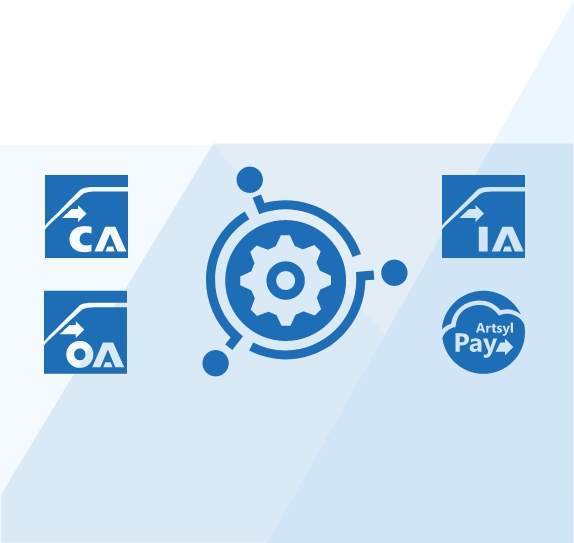Imagine ditching the paper trail and automating the exchange of invoices, purchase orders, and other crucial documents. Sounds pretty futuristic, right? Well, EDI is that future, and it’s here today! Electronic Data Interchange is a powerful tool that streamlines communication between businesses.
This article unveils the inner workings of EDI. We’ll explore its core concepts, the benefits it offers businesses of all sizes, and how it can revolutionize the way you interact with your trading partners. You will learn:
Get ready to unlock a world of efficiency, accuracy, and time savings – the EDI revolution is waiting!

Enhance data accuracy and efficiency by automating document capture and validation. See how docAlpha seamlessly integrates with your EDI for faster, error-free transactions.
What is EDI? How Do You Define Electronic Data Interchange?
EDI, or Electronic Data Interchange, might sound complex, but it boils down to a powerful and efficient way for businesses to communicate electronically. Imagine ditching the fax machines and mountains of paperwork – EDI automates the exchange of crucial business documents like invoices, purchase orders, and shipping notifications. Here’s a breakdown of the core concepts that make EDI tick.
Standardized Documentation Formats in EDI
Gone are the days of deciphering handwritten invoices. EDI utilizes standardized electronic formats, like EDIFACT or X12, ensuring all trading partners understand the information being exchanged. Just like a common language, these formats guarantee clear and consistent communication.
Electronic Data Exchange and Data Mapping
Different business systems have unique data structures. EDI uses data mapping to translate information from one system’s format to another. Think of it like an adapter that allows two devices with different plugs to connect seamlessly.
Electronic Communication in Electronic Data Exchange
EDI transactions don’t rely on snail mail or email. They leverage secure electronic channels, such as Value Added Networks (VANs) or cloud-based platforms, to ensure swift and reliable data exchange. Imagine sending documents instantly and securely, compared to the delays and potential risks of traditional methods.
Electronic Data Exchange and Trading Partners
Electronic Data Interchange is a two-way street. Businesses establish partnerships with their suppliers, customers, or other trading partners to electronically exchange documents. Imagine a network of businesses all speaking the same electronic language, streamlining communication and collaboration.
READ MORE: What Is Electronic Invoicing in Detail
Electronic Data Exchange: EDI Software
Special software acts as the translator between your internal business systems and the standardized EDI formats. This software prepares documents for transmission, translates incoming data, and integrates it seamlessly into your existing systems. Think of it as a translator app for business documents, ensuring smooth information flow.
By understanding these core concepts, you can gain a solid foundation for appreciating the power and benefits of Electronic Data Interchange. In the next section, we’ll look into the advantages EDI offers businesses and how it can revolutionize your operations!
Automate order processing and validation for flawless EDI transactions. See how OrderAction integrates seamlessly with your EDI for improved efficiency.
Try OrderAction today!
Book a demo now
How Electronic Data Interchange (EDI) Works
As we know already, Electronic Data Interchange (EDI) is a technology that facilitates the computer-to-computer exchange of business documents in a standardized electronic format between organizations. EDI replaces traditional paper-based documents, enabling companies to conduct business transactions more efficiently and accurately. Here’s a detailed look at EDI and its inner workings.
EDI Document Standards and Types Explained
EDI uses specific standards to format documents. Common standards include ANSI X12 (used mainly in North America), EDIFACT (used internationally), and TRADACOMS (used in the UK). These standards ensure that the data exchanged between different organizations’ systems are interpretable and consistent.
Electronic Data Interchange can handle various types of documents such as purchase orders, invoices, shipment notices, and payment instructions. Each document type has a specific format and structure defined by the EDI standard.
Translation Software Used by EDI
Translation software converts internal data formats to the standardized EDI format and vice versa. This software ensures that the data sent and received through Electronic Data Interchange can be understood and processed by the receiving system.The software also validates the data against EDI standards to ensure completeness and accuracy before transmission.
LEARN MORE: Best Practices for Accounts Payable Data Preparation
How Are Connected Electronic Data Exchange and Communication Networks?
Direct EDI involves a direct connection between two business partners using the same protocol. Examples include AS2 (Applicability Statement 2) and SFTP (Secure File Transfer Protocol).
EDI via Value-Added Networks (VANs) use third-party service providers that facilitate EDI by providing a secure, managed network for the exchange of EDI documents. VANs handle the routing and delivery of EDI messages, providing additional services like message tracking and auditing.
Benefits of Electronic Data Interchange
- Automation: Electronic Data Interchange automates the exchange of documents, reducing the need for manual intervention. This speeds up transaction processing and reduces the chance of human error.
- Faster Transactions: EDI significantly reduces the time taken to exchange documents compared to traditional mail or fax, enabling quicker decision-making and business cycles.
- Reduced Paperwork: By eliminating the need for paper documents, EDI reduces printing, postage, and storage costs.
- Lower Administrative Costs: Automation reduces the need for manual data entry and processing, leading to lower labor costs.
- Error Reduction: EDI minimizes errors associated with manual data entry, such as miskeying information or misinterpreting handwriting.
- Data Consistency: Standardized formats ensure that data is consistent and accurate, reducing discrepancies and the need for corrections.
- Secure Transmission: Electronic Data Interchange uses secure protocols and encryption to ensure that data is transmitted securely between trading partners.
- Audit Trails: EDI systems often provide detailed logs and audit trails, enhancing transparency and accountability in business transactions.
The Many Applications of Electronic Data Interchange (EDI)
Supply Chain Management
EDI is widely used to exchange purchase orders and invoices between retailers, manufacturers, and suppliers, streamlining procurement processes. Electronic Data Interchange also facilitates the exchange of shipping notices, customs documents, and other logistics-related information, improving supply chain visibility and efficiency.
Healthcare
EDI is used to submit healthcare claims, eligibility requests, and payment remittances between healthcare providers, insurers, and government agencies, enhancing the efficiency of healthcare administration. Electronic Data Interchange helps in the secure and standardized exchange of patient records and other healthcare data, ensuring accuracy and compliance with regulations like HIPAA.
Financial Services
In Electronic Funds Transfer (EFT), EDI is used to facilitate electronic payments and bank transactions, reducing processing times and improving financial reconciliation. Also, banks and financial institutions use EDI to send electronic account statements and payment notifications to their clients.
As you can see, Electronic Data Interchange (EDI) is a powerful tool that enables organizations to streamline their business processes, improve accuracy, and reduce costs by automating the exchange of standardized electronic documents.
By using EDI, businesses can enhance their operational efficiency, ensure data integrity, and maintain a competitive edge in today’s fast-paced digital economy.
Automate the capture and processing of invoices for faster, error-free EDI transactions. Discover the benefits of integrating InvoiceAction with your EDI. Explore InvoiceAction now!
Book a demo now
Which Technologies Enable Electronic Data Interchange (EDI)?
Electronic Data Interchange (EDI) relies on a combination of technologies to facilitate the secure and efficient exchange of business documents between organizations. Here’s a detailed look at the key technologies that enable EDI.
EDI Standards Explained
- ANSI X12: Widely used in North America, this standard covers a variety of business documents including purchase orders, invoices, and shipment notices.
- EDIFACT: The international EDI standard developed by the United Nations, commonly used in Europe and Asia.
- TRADACOMS: Used primarily in the United Kingdom, this standard is focused on the retail industry.
- HL7: Specific to the healthcare industry, HL7 standards facilitate the exchange of clinical and administrative data.
EDI Translation Software
EDI Translators are software applications that convert internal business documents into the standardized EDI format and vice versa. These translators ensure data consistency and compliance with EDI standards. Middleware solutions manage the data transformation and routing between internal systems and external trading partners, ensuring seamless integration.
EDI Mapping Tools
These tools help define how data from internal systems is translated into the EDI standard format and vice versa. They allow businesses to customize and manage their data mappings to ensure accurate and efficient data exchange.
DISCOVER MORE: Order Fulfillment Automation: Definition, Steps, Technology
EDI Communication Protocols
- AS2 (Applicability Statement 2): A popular protocol for securely exchanging EDI documents over the internet using HTTP/HTTPS. It ensures data integrity and privacy through encryption and digital signatures.
- FTP/SFTP (Secure File Transfer Protocol): Used for transferring files between systems over a secure connection, ensuring the confidentiality and integrity of the data.
- OFTP (Odette File Transfer Protocol): Commonly used in the automotive industry, OFTP supports secure and efficient data transfer between trading partners.
- VAN (Value-Added Network): A third-party network service that facilitates EDI communication by providing secure data transmission, message tracking, and other value-added services.
Electronic Data Interchange Integration Technologies
APIs (Application Programming Interfaces) enable real-time data exchange and integration between EDI systems and internal business applications, such as ERP (Enterprise Resource Planning) and CRM (Customer Relationship Management) systems.
Web services use standard protocols like SOAP (Simple Object Access Protocol) and REST (Representational State Transfer) to allow different systems to communicate and share data over the Internet.
B2B gateways are platforms that provide a centralized point for managing and automating the exchange of EDI documents between trading partners, supporting various communication protocols and standards.
EDI Security Technologies
Encryption ensures that EDI documents are transmitted securely by converting data into a coded format that can only be decoded by authorized parties.
Digital Signatures authenticate the identity of the sender and ensure the integrity of the document, preventing tampering during transmission.
Secure Sockets Layer (SSL)/Transport Layer Security (TLS) protocols provide secure communication channels over the internet, protecting data during transmission.
Cloud-Based EDI Solutions
Cloud EDI platforms offer EDI as a service, eliminating the need for on-premises infrastructure. They provide scalability, flexibility, and reduced maintenance costs. Managed EDI services are offered by third-party providers that manage the entire EDI process, including setup, monitoring, and maintenance, allowing businesses to focus on their core operations.
Overall, Electronic Data Interchange relies on a robust ecosystem of technologies to enable the seamless, secure, and efficient exchange of business documents between trading partners. From standardized formats and translation software to secure communication protocols and integration technologies, each component plays a crucial role in ensuring the success of EDI.
Automate the extraction and validation of critical data from your business documents. Experience how docAlpha transforms your EDI workflow, reducing manual intervention and errors. Explore docAlpha now!
Book a demo now
EDI Advanced Terms Explained: What You Need to Know
What Is Compliance Checking?
The process of validating EDI documents against industry standards and business rules. Compliance checking ensures that documents are correctly formatted and contain all necessary information, reducing the likelihood of errors and rejections by trading partners.
How Important Is Real-Time Processing?
The immediate processing of EDI transactions as they are received, enabling instant data exchange and response. Real-time processing enhances the efficiency and responsiveness of business operations, ensuring that critical information is available without delay.
What Is an EDI Envelope?
The structure used to group EDI documents for transmission. An EDI envelope contains a header and trailer that provide information about the sender, receiver, and contents of the transmission, ensuring that documents are correctly routed and processed upon receipt.
What Is the Role of Acknowledgment (ACK)?
A confirmation sent by the receiving party to acknowledge the receipt and acceptance of an EDI document. Acknowledgments ensure that documents have been successfully transmitted and processed, providing feedback on the status of the transaction.
What Is Batch Processing?
The aggregation of multiple EDI transactions for processing at a scheduled time. Batch processing is useful for handling large volumes of transactions efficiently, reducing the processing load on systems during peak times.
How Important Is EDI Integration?
The seamless connection of EDI systems with internal business applications like ERP (Enterprise Resource Planning) and CRM (Customer Relationship Management) systems. Integration ensures that EDI data is automatically updated and synchronized across all relevant systems, improving data accuracy and operational efficiency.
Understanding these key terms will help you navigate the world of EDI with greater confidence and clarity. Whether you’re implementing EDI for the first time or looking to optimize your existing processes, this glossary provides a solid foundation for your EDI knowledge.
Automate and streamline data capture from invoices, orders, and more. See how docAlpha’s robust features enhance your EDI for better accuracy and efficiency. Discover the power of docAlpha now!
Book a demo now
Final Thoughts: Embrace the Future of Business Communication with EDI
Now that you’ve demystified EDI, envision the possibilities! Here’s a glimpse of the transformation EDI can bring:
- Reduced costs: Forget about manual data entry errors and paper-based processes. EDI saves money and boosts efficiency.
- Enhanced accuracy: Automated data exchange minimizes errors and ensures information consistency throughout the supply chain.
- Faster transactions: Streamlined processes lead to quicker invoicing, faster payments, and improved cash flow.
- Improved relationships: EDI fosters stronger partnerships with your trading partners through seamless communication.
- Increased visibility: Gain real-time insights into your transactions, allowing for better inventory management and informed decision-making.
EDI is not just a technology, it’s a strategic advantage. By embracing EDI, you can transform your business from paper-pushing to performance-driven, achieving greater efficiency and propelling yourself towards success. So, are you ready to join the EDI revolution?




 Data Extraction Tools for Business Optimization
Data Extraction Tools for Business Optimization The Power of Data Management
The Power of Data Management How Data Analytics Drives Process Automation to Success
How Data Analytics Drives Process Automation to Success Data Extraction: Definition, Techniques, Uses
Data Extraction: Definition, Techniques, Uses Data Entry: Transform Your Workflows
Data Entry: Transform Your Workflows Intelligent Data Extraction with AI: How to Use
Intelligent Data Extraction with AI: How to Use